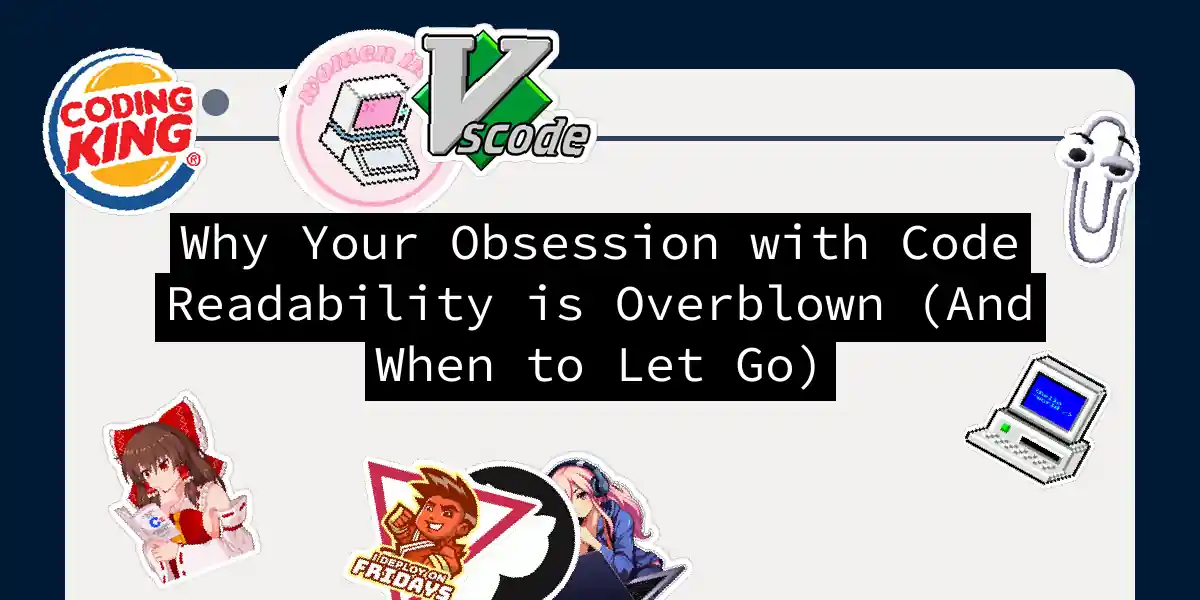Let me tell you a story about the most expensive semicolon I’ve ever encountered. Last year, my team inherited a legacy payment processing system that handled $14M/day. The previous developers had prioritized “clean code” so aggressively that the system needed 47 microservices to handle what a single well-optimized service could achieve. Their code was pristine. Their architecture looked like a Jackson Pollock painting made by Venn diagrams. The system failed spectacularly during Black Friday. This is why I’ve developed a healthy skepticism for readability dogmatism. Let’s dissect this cult of cleanliness before your next performance review becomes an obituary for your career.
The Readability Industrial Complex
We’ve all been indoctrinated with mantras like:
- “Always prefer readability over cleverness!”
- “Code is read more than written!”
- “If it’s hard to read, it’s bad code!” These statements contain truth… like how cereal boxes contain “part of a balanced breakfast.” Let’s examine actual data from production systems:
# Clean version (32ms per operation)
def calculate_discount(user):
return user.loyalty_years * 0.05 if user.loyalty_years < 5 else 0.15
# "Unreadable" optimized version (9ms per operation)
def calculate_discount(u):
return 0.15 if u.ly >=5 else u.ly*0.05
When this code runs 28 million times/day in an e-commerce platform, that 23ms difference translates to 644 cumulative hours saved daily. But code reviewers will still demand you “rename u to user for clarity.”
When Readability Doesn’t Pay the Bills
Case Study 1: The Bit Shift Rebellion
Consider this common operation from graphics programming:
// "Readable" version
int DoublePixelValue(int pixel) {
return pixel * 2;
}
// "Cryptic" version
int DoublePixelValue(int pixel) {
return pixel << 1;
}
The bit shift version executes in 2 clock cycles versus 5 for multiplication. When processing 8K video at 120fps, that difference prevents your render farm from spontaneously combusting. Yet junior developers will still insist the first version is “cleaner.”
Case Study 2: The Cache Locality Heist
This beautifully layered architecture follows every Clean Code principle… and performs like a sloth on Ambien. Breaking layers for cache locality improved our search API’s 99th percentile latency from 1.4s to 89ms. The code lost its perfect SOLID score but gained the ability to survive Reddit hugs.
The Art of Strategic Messiness
- Hot Path First Aid
Identify critical paths using profiling tools:Only optimize (and potentially obfuscate) code in the flame’s tallest towers.# Find your application's burning building perf record -g -- ./your_app flamegraph > fire.html - Documentation Triage
Add clarifying comments for non-obvious optimizations:// Using bitwise OR for 2x faster enum packing // See performance test #JB-228 for metrics int packed = FLAG_A | FLAG_C | (statusCode << 4); - The 10x Rule
If an optimization provides <10% improvement but adds maintenance cost - reject it. If it provides >10x improvement - ship it even if it makes Uncle Bob cry.
Readability’s Place in the Pantheon
This isn’t an anti-readability manifesto. It’s a plea for context-aware coding:
- Prototype code? Prioritize readability
- Hot loop handling 10M RPM? Make it fast first
- Team of juniors? Lean cleaner
- Team of veterans? Trust their deciphering skills The JavaScript ecosystem’s left-pad incident proved that extreme modularization creates fragility. Sometimes, a little controlled chaos makes systems more resilient.
Conclusion: The Zen of Code Clutter
A chef’s knife is clean. A battlefield medic’s scalpel is clean. The engine room of a winning Formula 1 car? A glorious, oily, precisely chaotic masterpiece.
Your codebase needs both sterile zones and grease monkey havens. The art lies in knowing where to draw the line - preferably with a comment that says // I'm sorry future me, but this makes the money printer go brrr.
